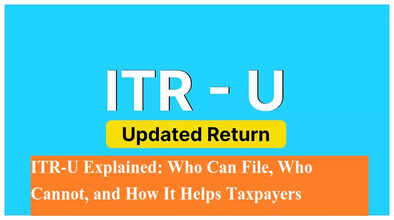ITR-U Explained: Who Can File, Who Cannot, and How It Helps Taxpayers

Filing income tax returns can be stressful, and mistakes often happen despite the best efforts of taxpayers. To address such errors and promote honest tax reporting, the government has introduced the ITR-U (Updated Income Tax Return) facility. This provision allows individuals to correct mistakes or omissions in their previously filed returns, ensuring transparency while avoiding legal complications. Let’s understand what ITR-U is, who can file it, and the rules surrounding it.
What is ITR-U?
ITR-U stands for Updated Income Tax Return. It is a special form introduced by the Central Board of Direct Taxes (CBDT) that allows taxpayers to make corrections in their earlier filed ITRs.
Under Section 139(8A) of the Income Tax Act, this facility empowers taxpayers to update or rectify errors in their tax filings—whether they forgot to include certain income, reported incorrect details, or missed filing the return altogether.
Why Was ITR-U Introduced?
The government rolled out ITR-U through the Finance Act 2022 and further updated its provisions in the Finance Act 2025. The main goal behind this initiative is to encourage voluntary tax compliance.
Many taxpayers unintentionally leave out income or make mistakes that might otherwise be considered tax evasion. With ITR-U, they get a chance to correct these errors without facing harsh penalties or legal troubles.
What Can Be Done Through ITR-U?
If you made mistakes while filing your return, ITR-U provides an opportunity to set things right. Taxpayers can use it to:
-
Add omitted income that was not disclosed earlier.
-
Correct wrong information previously reported.
-
Rectify other errors in their original, revised, or belated returns.
In short, ITR-U works as a safety net to maintain accuracy and compliance in tax reporting.
Who Can File ITR-U?
ITR-U is beneficial for:
-
Individuals who missed filing their original return on time.
-
Those who did not submit a revised return or belated return.
-
Taxpayers who need to rectify mistakes in their previously filed ITRs.
This form essentially offers a second chance to ensure that all tax details are correctly reported.
Time Limit for Filing ITR-U
Taxpayers get a fairly generous window to file ITR-U. It can be filed within 48 months (4 years) from the end of the relevant assessment year. This extended timeline ensures that individuals have ample opportunity to review and correct their filings.
Additional Tax Liability on ITR-U
While ITR-U offers relief, it comes with an extra tax cost. Taxpayers must pay an additional percentage over their regular tax liability, depending on how late they file the updated return:
-
Within 12 months: 25% additional tax
-
Within 24 months: 50% additional tax
-
Within 36–48 months: 70% additional tax
This ensures that taxpayers are encouraged to make corrections early rather than delaying them.
Who Cannot File ITR-U?
It’s equally important to note that not everyone is eligible. You cannot file ITR-U if:
-
Your updated return leads to a lower tax liability than previously reported.
-
You want to claim or increase a refund.
-
Your case involves search and seizure operations under income tax law.
Final Takeaway
The introduction of ITR-U is a forward-looking step by the government to make tax compliance easier and more transparent. It not only provides taxpayers with an opportunity to correct genuine mistakes but also helps the system reduce litigation over small errors.
If you have missed reporting income, made calculation errors, or forgot to file your return, ITR-U is your second chance to stay compliant and avoid penalties. However, keep in mind the extra tax liability and the strict timelines while using this facility.

